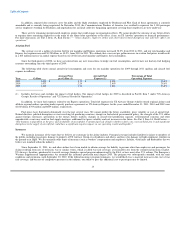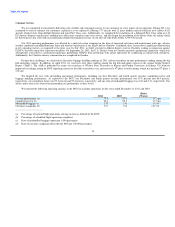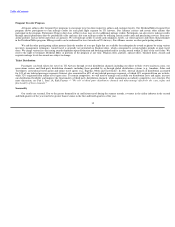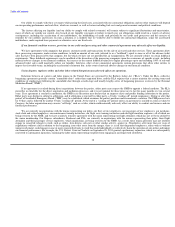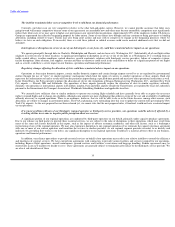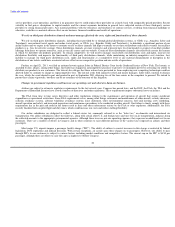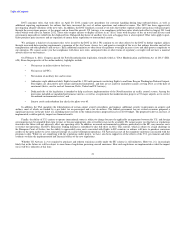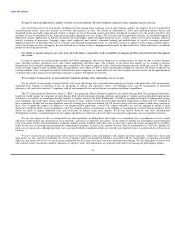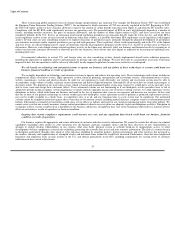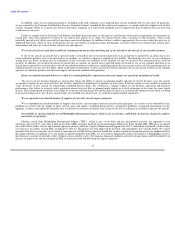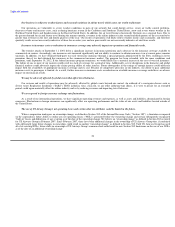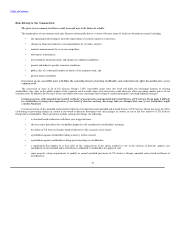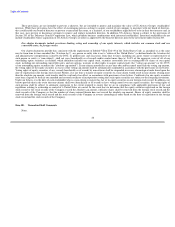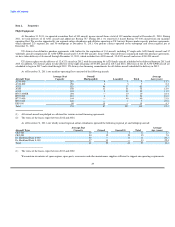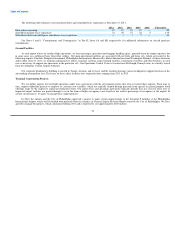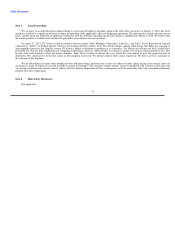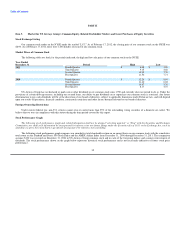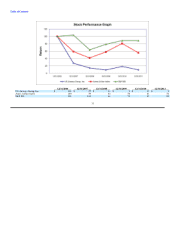US Airways 2011 Annual Report Download - page 26
Download and view the complete annual report
Please find page 26 of the 2011 US Airways annual report below. You can navigate through the pages in the report by either clicking on the pages listed below, or by using the keyword search tool below to find specific information within the annual report.
Table of Contents
We may be adversely affected by conflicts overseas or terrorist attacks; the travel industry continues to face ongoing security concerns.
Acts of terrorism or fear of such attacks, including elevated national threat warnings, wars or other military conflicts may depress air travel, particularly
on international routes, and cause declines in revenues and increases in costs. The attacks of September 11, 2001 and continuing terrorist threats and
attempted attacks materially impacted and continue to impact air travel. Increased security procedures introduced at airports since the attacks and other such
measures as may be introduced in the future generate higher operating costs for airlines. The Aviation and Transportation Security Act mandated improved
flight deck security, deployment of federal air marshals on board flights, improved airport perimeter access security, airline crew security training, enhanced
security screening of passengers, baggage, cargo, mail, employees and vendors, enhanced training and qualifications of security screening personnel,
additional provision of passenger data to U.S. Customs and enhanced background checks. A concurrent increase in airport security charges and procedures,
such as restrictions on carry-on baggage, has also had and may continue to have a disproportionate impact on short-haul travel, which constitutes a significant
portion of our flying and revenue.
Our ability to operate and grow our route network in the future is dependent on the availability of adequate facilities and infrastructure throughout
our system.
In order to operate our existing flight schedule and, where appropriate, add service along new or existing routes, we must be able to obtain adequate
gates, ticketing facilities, operations areas, slots (where applicable) and office space. For example, at our largest hub airport, we are seeking to increase
international service despite challenging airport space constraints. The nation's aging air traffic control infrastructure presents challenges as well. The ability
of the air traffic control system to handle traffic in high-density areas where we have a large concentration of flights is critical to our ability to operate our
existing schedule. Also, as airports around the world become more congested, we cannot always be sure that our plans for new service can be implemented in
a commercially viable manner given operating constraints at airports throughout our network.
We are subject to many forms of environmental regulation and may incur substantial costs as a result.
We are subject to increasingly stringent federal, state, local and foreign laws, regulations and ordinances relating to the protection of the environment,
including those relating to emissions to the air, discharges to surface and subsurface waters, safe drinking water, and the management of hazardous
substances, oils and waste materials. Compliance with all environmental laws and regulations can require significant expenditures.
The U.S. Environmental Protection Agency ("EPA") has proposed effluent limitation guidelines for airport deicing fluid. This proposed technology-
based rule would require the mitigation of spent deicing fluid (glycol) discharges through collection and treatment. Airports meeting threshold requirements
would have to construct or reconfigure deicing facilities to capture and treat the fluid. Additionally, the EPA has proposed changes to underground storage
tank regulations that could affect certain airport fuel hydrant systems. Airport systems that fall within threshold requirements would need to be modified to
meet regulations. Neither rule has been finalized, and cost estimates have not been defined, but US Airways along with other airlines would share a portion of
these costs at applicable airports. In addition to the proposed EPA regulations, several U.S. airport authorities are actively engaged in efforts to limit
discharges of deicing fluid to local groundwater, often by requiring airlines to participate in the building or reconfiguring of airport deicing facilities. Such
efforts are likely to impose additional costs and restrictions on airlines using those airports. We do not believe, however, that such environmental
developments will have a material impact on our capital expenditures or otherwise adversely affect our operations, operating costs or competitive position.
We are also subject to other environmental laws and regulations, including those that require us to remediate soil or groundwater to meet certain
objectives. Under federal law, generators of waste materials, and owners or operators of facilities, can be subject to liability for investigation and remediation
costs at locations that have been identified as requiring response actions. Liability under these laws is often strict, joint and several, meaning that we could be
liable for the costs of cleaning up environmental contamination regardless of fault or the amount of wastes directly attributable to us. We have liability for
such costs at various sites, although the future costs associated with the remediation efforts are currently not expected to have a material adverse effect on our
business.
We have various leases and agreements with respect to real property, tanks and pipelines with airports and other operators. Under these leases and
agreements, we have agreed to indemnify the lessor or operator against environmental liabilities associated with the real property or operations described
under the agreement, even if we are not the party responsible for the initial event that caused the environmental damage. We also participate in leases with
other airlines in fuel consortiums and fuel committees at airports, where such indemnities are generally joint and several among the participating airlines.
23


